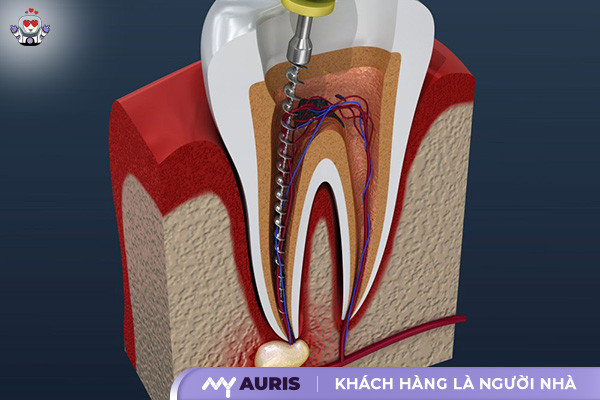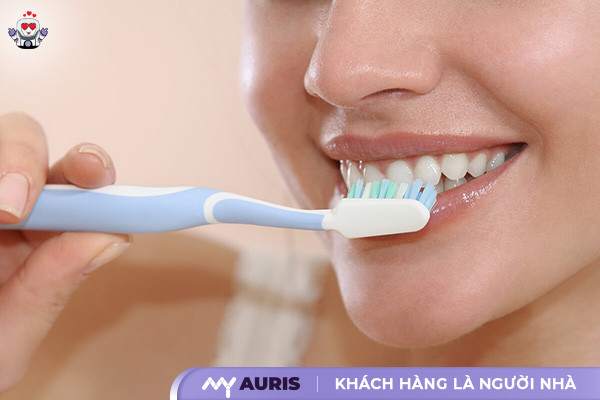Should a tooth that has undergone root canal treatment be crowned? The answer is YES. After root canal treatment, the natural tooth often becomes brittle and fragile due to the loss of the nourishing pulp tissue. Therefore, it is advisable to get a ceramic crown as soon as possible to provide stronger protection for the tooth, maintain its chewing function, and improve the aesthetics of your smile. Crowning not only helps preserve the natural tooth but also prevents the risk of future damage.
Should a root-canal-treated tooth be crowned?
If you have had a tooth, especially a molar or a large devitalized tooth, undergo root canal treatment, then a dental crown is an essential restorative step. It not only protects the natural tooth but also maintains chewing function, prevents complications, increases the tooth’s lifespan, and improves smile aesthetics.
After root canal treatment, teeth often become weaker due to the loss of their nutritional supply. The natural tooth structure at this point becomes brittle and prone to cracking or fracturing when chewing forcefully or under daily stress. This is particularly true for molars and incisors – teeth that bear significant chewing forces – where leaving them unrestored poses a high risk to the chewing system and overall tooth structure.
Dental crowning is a solution recommended by dentists to restore teeth after endodontic treatment. When a porcelain crown is bonded to a root-canal-treated tooth, it acts as a protective layer, preventing the tooth from breaking, restoring chewing function, and maintaining aesthetics. Additionally, devitalized teeth often darken over time. Crowning helps improve the appearance of the smile while protecting the tooth root from physical impacts.
Depending on the specific tooth location and condition, your dentist will assess whether a crown is necessary. For molars or teeth with extensive decay, or a fractured crown, a dental crown after root canal treatment is almost mandatory. For small incisors or teeth under less stress, aesthetic fillings may be an option in some cases. However, fillings are generally not as durable as crowns and can dislodge after a few years.
A root-canal-treated tooth no longer has nerves, so if it cracks from within, it won’t cause pain, potentially leading to irreversible tooth loss. Proactive crowning helps prevent tooth fractures, extends the lifespan of the natural tooth, and minimizes future treatment costs.
Crowning a tooth after root canal treatment increases its strength, restoring the tooth almost completely in terms of shape, function, and aesthetics. Patients can chew almost normally without worrying about tooth weakness. This is an integral part of comprehensive dental treatment and is widely applied in reputable dental clinics.

What is a root-canal-treated tooth? Why is root canal treatment necessary?
A root-canal-treated tooth is a tooth that has undergone treatment to remove the pulp inside its root. This is a common dental procedure, known as endodontic treatment. The main goal is to prevent infection from spreading and to save the natural tooth instead of extracting it. When the pulp is damaged or necrotic, the tooth no longer has nerves, so it loses the sensation of pain but can still maintain chewing function if restored correctly.
The dental pulp is located in the center of the tooth structure, comprising nerves, blood vessels, and connective tissue. It plays a role in nourishing the tooth and sensing external stimuli. However, the pulp is highly susceptible to damage from extensive tooth decay, large fractures, or severe trauma. Once the pulp becomes inflamed, bacteria can invade and cause pain, affecting both the chewing system and overall health.
Root canal treatment is a crucial step in the dental treatment process. The dentist will create an access opening to the pulp canal, thoroughly clean and disinfect it. Afterward, the pulp canal is sealed with a specialized material to prevent bacteria from returning. This process helps protect the tooth root, reduces the risk of tooth loss, and prepares for the subsequent restorative phase with a ceramic crown or filling.
After root canal treatment, teeth often become brittle and weak due to the loss of nutrients from the pulp tissue. Therefore, most patients are recommended to get a dental crown to increase durability, prevent cracking, and restore chewing function. Especially for molars – which bear significant force – crowning helps avoid the risk of unwanted tooth fractures.
Timely root canal treatment not only helps save the natural tooth but also reduces future treatment costs. If pulp inflammation is left untreated, bacteria can destroy the tooth root, spreading to the gums or jawbone, leading to permanent tooth loss. In many cases, restoring a devitalized tooth with a zirconia crown or an all-ceramic crown yields excellent aesthetic results and ensures long-term health.

Do teeth weaken after root canal treatment?
When a tooth experiences pulp inflammation, severe decay, or trauma leading to pulp necrosis, the patient needs endodontic treatment to remove the damaged pulp. However, many people are concerned about whether the tooth will remain strong or become brittle and prone to fracture after root canal treatment. This is a common concern in the field of dentistry and tooth restoration today.
The truth about tooth structure after root canal treatment
The dental pulp is an internal system of blood vessels and nerves that nourishes the tooth and maintains its sensation. Once the pulp is removed, the tooth no longer receives natural nutrition. This negatively alters the tooth structure. The dentin becomes dry and brittle, and its ability to withstand force is significantly reduced. A root-canal-treated tooth no longer feels pain, so many damages are not detected early. This is why dentists recommend restoring teeth after endodontic treatment.
Impact of pulp loss on tooth durability
According to clinical statistics, teeth after root canal treatment have a 2-3 times higher risk of fracture or cracking compared to vital teeth. The reason is that the tooth no longer has the ability to absorb and distribute chewing forces, especially in molars. In the chewing system, molars play a primary role in grinding food, so the forces applied are very strong. If not restored properly, the tooth will gradually lose function, affecting the entire dental restorative system.
Reasons why root-canal-treated teeth are prone to damage
The structure of a tooth after root canal treatment loses the elasticity of living tissue. The tooth tissue becomes hard but brittle, especially the dentin. The tooth also loses its ability to adapt to temperature changes, biting forces, or bacteria. In many cases, patients who underwent root canal treatment but did not have restorations experienced horizontal tooth fractures, exposed dentin, or root cracks, necessitating extraction.
Solutions for protecting root-canal-treated teeth
To minimize the risk of fracture, restoration with a dental crown is a crucial next step. Crowning helps cover and protect the entire remaining natural tooth, supports chewing function, and enhances aesthetics. Ceramic crowns like zirconia offer high durability, extending the tooth’s lifespan by 10-15 years. For incisors or teeth under less stress, a filling may be chosen if the tooth structure is still good.
Current options for crowning teeth after root canal treatment
Currently, there are three main groups of dental crowns used to restore teeth after root canal treatment, each with its own advantages and disadvantages, depending on the patient’s aesthetic needs, function, and financial considerations.
Metal-ceramic crowns (Ni-Cr, Cr-Co)
These are dental crowns with a metal framework and an outer ceramic layer. This type has a lower cost and is often used for molars, where high chewing force is more critical than aesthetics. However, over time, the gum line may darken due to oxidation. It is suitable for patients concerned about cost and with fewer aesthetic demands.
Titanium crowns
Titanium crowns are an improved version of metal-ceramic crowns. Titanium is less allergenic and has high biocompatibility with gum tissue. This type is suitable for individuals with a history of metal allergies or those who need a highly durable crown without excessive cost. Titanium crowns are less prone to darkening at the gum line than conventional Ni-Cr types.
All-ceramic crowns (Zirconia, E.max)
This is the most premium option, offering the ability to mimic the natural tooth shape, natural color, and high durability. Zirconia crowns are often chosen for both front and back teeth because they meet both aesthetic demands and good chewing force resistance. This is the top choice for patients seeking aesthetic, long-lasting dental crowns with minimal complications.
Important considerations after crowning a root-canal-treated tooth
To ensure chewing function, aesthetics, and durability after endodontic treatment, patients should follow proper care and recall instructions as recommended by their dentist. Below are practical, easy-to-follow guidelines that can be applied at home.

Proper oral hygiene after dental crowning
After crown placement, maintain regular oral hygiene by brushing your teeth at least twice a day. Use a soft-bristled toothbrush and non-abrasive toothpaste to avoid scratching the ceramic surface.
Use dental floss or a water flosser to clean between teeth, especially the area where the crown meets the tooth root. Accumulated plaque can lead to gum inflammation or exposed crown margins, reducing the lifespan of the all-ceramic crown.
Rinse your mouth with physiological saline or antibacterial mouthwash after each meal to prevent bacteria and bad breath from developing in the restored tooth area.
Avoid chewing hard or excessively hot/cold foods
Although dental crowns are highly durable, they can still crack or fracture if subjected to continuous strong forces. Avoid using crowned teeth to bite hard nuts, chew ice, or open bottle caps. These actions can cause the crown to crack or dislodge from the tooth stump.
Excessively hot or cold foods should also be limited. Since devitalized teeth lack sensation, it’s not easy to detect when a crown is damaged by temperature changes. Furthermore, temperature differences can affect the bonding agent between the crown and the natural tooth.

Regular check-ups and monitoring of the restoration
Patients who have undergone root canal treatment and received a dental crown should visit the dental clinic for check-ups every 6 months. The dentist will examine the condition of the crown, assess its adhesion, observe the tissue around the tooth root, and detect early signs of open, misaligned, or fractured restorations.
If you experience any unusual symptoms such as prolonged sensitivity, pain when biting, bad breath, or bleeding gums – you should return to the dentist immediately to have the crown and tooth root checked. Early intervention helps preserve the crown and prevents more complex complications such as infection or the need for crown replacement.
Lifestyle habits that support the longevity and beauty of dental crowns
Avoid teeth grinding during sleep by using an occlusal guard if prescribed by your dentist. Uncontrolled teeth grinding is a primary cause of reduced lifespan for dental crowns, especially zirconia crowns and other aesthetic ceramic types.
Do not smoke, and limit alcohol and dark-colored beverages like coffee and black tea. Although ceramic crowns do not stain like natural teeth, these drinks can still affect the gum line and cause discoloration around the restoration.
Maintain a balanced diet, supplementing calcium and vitamin D to support the health of the tooth tissue around the tooth root. This is especially crucial in the chewing system, which bears heavy forces in molars.
Understand the limitations of dental crowns
A dental crown is not a “natural tooth” and does not last forever. The average lifespan of a crown ranges from 7 to 15 years, depending on the type, material, and care. Expecting a crown to never fail or require no maintenance is a common misconception.
Patients who have undergone root canal treatment need to understand that devitalized teeth no longer have nerves, making it difficult to detect damage. Maintaining a dental crown requires a combination of home care and professional follow-ups at the clinic.
Finally, choose a reputable dental clinic with expertise in dental restoration and endodontic treatment to ensure the crown is placed with proper technique and is safe for the remaining tooth structure.





